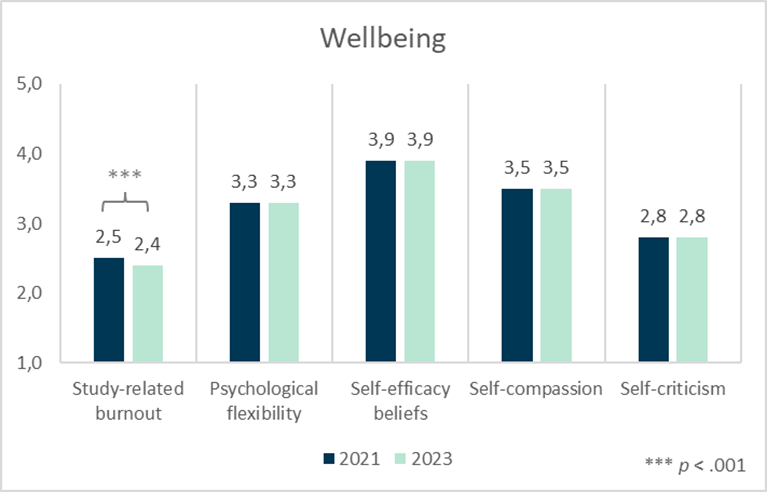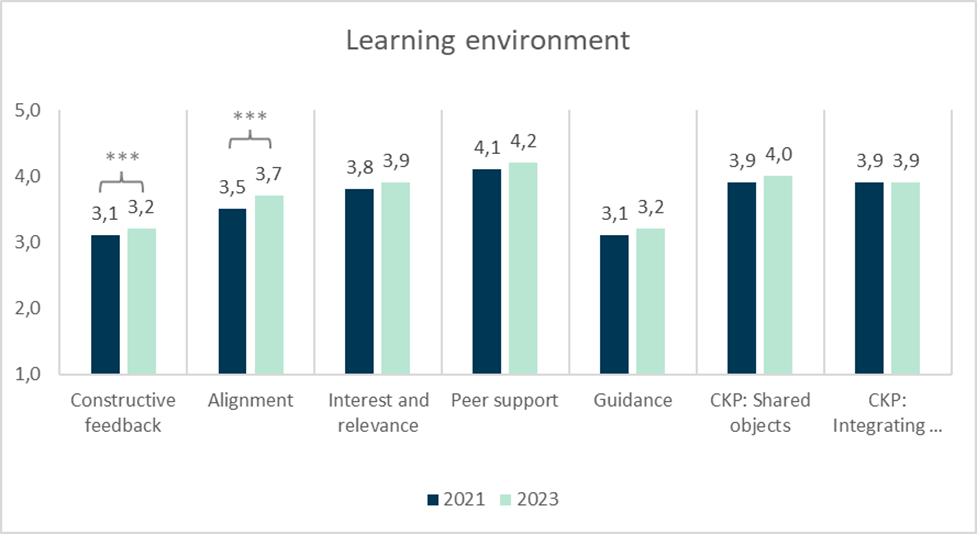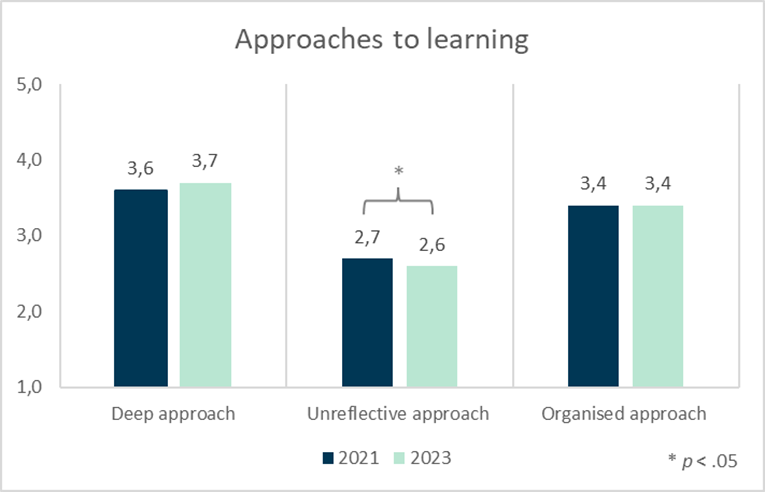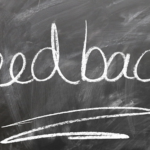
Merly Kosenkranius, Sara Rönkkönen & Telle Hailikari
Over the past few years, higher education students’ wellbeing and ability to study have been put to the test. The COVID-19 pandemic and the need for students to adapt to distance learning, followed by the overall uncertain world situation, have challenged students’ already precarious well-being and study ability. At the Häme University of Applied Sciences (HAMK), efforts have been made to give students an opportunity to systematically reflect on their wellbeing and learning experiences. Observing the trends in students’ wellbeing and learning experiences over time is not only valuable for students’ self-reflection but also offers valuable information from the pedagogical development point of view. In this paper, we present how the trends in HAMK’s first-year students’ wellbeing and learning experiences have changed over time. Our aim is to report the key changes in the trends of the phenomena examined with the LearnWell study experience questionnaire. With a repeated cross-sectional study design, we compare the dataset collected in spring 2021 to the one collected in spring 2023.
Introduction, key concepts & previous research
The LearnWell research group in HAMK Edu research area conducts an annual study experience questionnaire to HAMK’s first- and second-year students. The LearnWell study experience questionnaire measures students’ experiences of their learning processes, learning environment, general work-life competencies, and study-related wellbeing. Since 2021, over 2000 students have replied to the questionnaire. The LearnWell questionnaire is based on the HowULearn questionnaire, developed at the University of Helsinki (Hailikari & Parpala, 2014; Parpala & Lindblom-Ylänne, 2012) and validated in previous studies (Herrmann et al., 2017; Parpala et al., 2013). HAMK’s LearnWell research group has developed the questionnaire instrument further and contextualized it for universities of applied sciences, also aligning it with Finnish Student Health Services’ study ability model (FSHS, n.d.; Lahdenperä & Virtanen, 2022).
In this paper, we utilize two LearnWell datasets collected at two different time points (spring 2021 and spring 2023). Respondents in 2023 are different from those in 2021. The students answering the questionnaire have been first-year students during both timepoints. The repeated cross-sectional study design allows us to study trends over time, but not the change on an individual level. Detecting the change in trends is particularly important considering the exceptional time of the first measurement point (spring 2021), which was still heavily influenced by the COVID-19 pandemic and online teaching.
Key phenomena of the study
In the present study, students’ psychological wellbeing is conceptualised as consisting of psychological flexibility, self-efficacy, self-compassion, self-criticism, and the risk of burnout. Psychological flexibility refers to person’s ability to flexibly direct their own behaviour and attention towards actions that are meaningful and in line with their personal values even in emotionally challenging situations (Chawla & Ostafin, 2007; Hayes et al., 2006). Thus, it is closely related to the concept of resilience. Self-efficacy is a central expectancy construct that describes one’s belief in their ability to successfully complete a task in a specific context (Bandura, 1997). Self-efficacy increases one’s sense of being in control of the situation and may thus be seen as an important variable influencing wellbeing. Self-compassion, on the other hand, refers to the ability to remain kind, warm, and understanding towards oneself even when facing difficulties (Neff, 2003) and is thus an important wellbeing variable. Conversely, self-criticism refers to being overly harsh and critical towards oneself (López et al., 2015). This poses a threat to wellbeing as it has been linked to feelings of inadequacy and burnout (C. Richardson et al., 2020). And lastly, in the higher education context, study-related burnout is often conceptualised through three dimensions: exhaustion, cynicism, and feeling of inadequacy (Salmela-Aro et al., 2009). Study-related burnout is conceived as an imbalance between study-related demands and the feeling of being able to respond to them (Salmela-Aro & Read, 2017). Exhaustion refers to feeling strained and fatigued, while cynicism refers to losing interest in one’s own study field and not experiencing it as meaningful anymore (Schaufeli et al., 2002). Lastly, the feeling of inadequacy refers to the perception of not being competent enough to succeed (Salmela-Aro et al., 2009).
In the present study, experiences of the teaching-learning environment are conceptualised through the concepts of constructive feedback, alignment, peer support, and interest and relevance towards the studied subject (Asikainen et al., 2014; Parpala & Lindblom-Ylänne, 2012; see also Herrmann et al., 2017). Previous research has found that positive perceptions of these dimensions of the teaching-learning environment are linked to higher-quality learning (e.g., Richardson, 2006). Constructive feedback refers to the feedback students receive on their work and whether it is experienced as improving their learning and studying (Entwistle et al., 2003). Alignment refers to the teaching-learning environment where all elements, such as learning objectives, teaching-learning activities, and assessment are aligned with each other and support students’ deep approach to learning (Biggs, 1996).Support that students give to each other, that is peer support, is also an important element of an environment supporting students’ learning (Rytkönen et al., 2012). The interest and relevance dimension refers to students’ interest towards their field and in their perception of the relevance of the learning content (Parpala & Lindblom-Ylänne, 2012). Additionally, in this report, two of the four factors of Collaborative Knowledge Processes (CKP; Muukkonen et al., 2020), namely Learning to collaborate on shared objects and Integrating individual and collaborative working, are grouped within the area of a learning environment. The two factors measure group work skills, both from the point of view of shared goals and competencies to work as a group.
In the higher education context, students’ learning is often conceptualised through the concept of approaches to learning. Approaches to learning refer to students’ intentions concerning their studies and learning processes. Research has identified three different approaches to learning: first, deep approach to learning refers to students’ intention to learn through analysing and forming a coherent understanding of the information, relating ideas and using evidence as well as integrating knowledge to previous understanding (Biggs, 2001; Entwistle, 2009). Second, the surface, nowadays labelled as an unreflective approach to learning, is characterised by memorisation of the information which often results in a fragmented knowledge base and not reflecting on the learnt information (Lindblom-Ylänne et al., 2018). The third approach, organised studying, refers to students’ ability to manage their time and effort (Entwistle & McCune, 2004). On an individual level, research has shown that organised studying remains rather stable whereas deep and surface approach may vary across contexts (Postareff et al., 2018).
The aim of this paper is to present trend-level changes in the phenomena related to HAMK’s first-year students’ study experiences. Firstly, we show how the trends in study-related wellbeing, namely psychological flexibility, self-efficacy, self-compassion, self-criticism, and study-related burnout, have changed over time. Secondly, we report the change in the learning environment, namely peer support, feedback, alignment, interest and relevance, learning to collaborate on shared objects, and integrating individual and collaborative working. Thirdly, we study the change in the trends of approaches to learning; deep approach to learning, unreflective approach to learning, and organised studying. The measured dimensions presented in this paper are aligned with the ones from which HAMK students receive group and individual-level feedback after replying to the LearnWell questionnaire. Degree programmes receive the reports accordingly from the same scales on a group level.
Methods
Context and participants
First-year students filled in the LearnWell questionnaire online in spring 2021 and in spring 2023. After data cleaning processes, the final sample consisted of 680 students in 2021 and 798 students in 2023. In 2021, the students in the target group were given a short introduction to the LearnWell questionnaire before receiving a link to the questionnaire. The students replied either on their own time or during a teaching session. In 2023, students answered the LearnWell questionnaire during degree programme-specific sessions that, in most cases, were integrated into regular teaching, either on-site or online. The sessions started with an introduction to LearnWell as in 2021. In 2023, after answering the questionnaire, in most of the degree programmes, the results were presented by and discussed with the study counsellor and members of the research team.
There were some differences between the 2021 and 2023 samples in background characteristics. On average, the 2021 sample was somewhat younger (M = 26.5, SD = 7.9) than the 2023 sample (M = 28.2, SD = 8.3). In both samples, participants identifying as females formed the largest group (63 and 59%), followed by male (36 and 38%) and non-binary participants (less than one and two per cent). In both samples, there was about one per cent of participants who did not wish to disclose information about their gender.
In 2021, there were more full-time students (82%) among the respondents compared to the 2023 sample (70%). Both in 2021 and 2023, most participants answered the questionnaire in Finnish, however, the proportion of English-speaking participants increased from approximately 6 percent in 2021 to 20 percent in 2023. The proportion of participants from different schools was quite similar, 25 and 23 per cent from the School of Bioeconomy, 51 and 59 per cent from the School of Entrepreneurship, Business, and Technology, and 25 and 19 per cent from the School of Wellbeing in 2021 and 2023 respectively.
Measures
The LearnWell questionnaire consists of four sections, measuring aspects of students’ learning processes, learning environment, experiences in competency development, and study-related wellbeing. Students indicated their level of (dis)agreement with each study item on a five-point Likert scale. In this study, student wellbeing was measured with scales measuring self-efficacy (Parpala & Lindblom-Ylänne, 2012), study-related burnout (SBI; Salmela-Aro et al., 2009), psychological flexibility (Asikainen et al., 2018; Bond et al., 2013), self-compassion and self-criticism (SCS; López et al., 2015; Neff, 2003). Experiences of the learning environment were measured with scales assessing alignment, interest and relevance, constructive feedback, and guidance (Parpala & Lindblom-Ylänne, 2012). Students’ collaborative learning skills were measured with two subscales of CKP (Muukkonen et al., 2020): 1) learning to collaborate on shared objects, and 2) integrating individual and collaborative working focus on developing. Learning processes were measured with approaches to learning scale (Parpala & Lindblom-Ylänne, 2012).
Analysis
To investigate potential differences in first-year students’ study-related wellbeing, experiences of the learning environment, and approaches to learning in 2021 and 2023, we conducted independent sample t-tests, comparing the two student samples on key outcome variables. The analyses were carried out in SPSS version 29.
Findings
Trends in student wellbeing 2021–2023
Our analyses showed that the 2023 sample reported statistically significantly lower levels of study-related burnout (M = 2.4, SD = 0.9) compared to the 2021 sample (M = 2.5, SD = 0.9, t(1476)= 3.74, p < .001). Moreover, this positive trend was also visible in terms of all three subdimensions of study-related burnout. Namely, the 2023 sample had significantly lower scores on exhaustion, cynicism, and inadequacy compared to the 2021 sample. Differences between the student groups were statistically non-significant on the other wellbeing outcomes, indicating that first-year students’ psychological flexibility, self-efficacy, self-compassion, and self-criticism were at similar levels in 2021 and 2023. All means are shown in Figure 1.

Trends in learning environment experiences 2021–2023
Comparison of different learning environment experiences revealed statistically significant differences in constructive feedback and alignment. The 2023 sample had statistically significantly higher constructive feedback scores (M = 3.2, SD = 0.7) compared to the 2021 sample (M = 3.1, SD = 0.8, t(1474)= -3.27, p < .001). Similarly, students in 2023 scored statistically significantly higher on alignment (M = 3.7, SD = 0.7) than students in 2021 (M = 3.5 SD = 0.7, t(1474)= -4.15, p < .001). This shows positive trends in constructive feedback and alignment. There were no statistically significant differences between the two student groups in the CKP dimensions of 1) learning to collaborate on shared objects and 2) integrating individual and collaborative working. In addition, there were no significant differences between the groups on other learning environment experiences (i.e., peer support, guidance, and interest and relevance). All means for both groups on learning environment experiences are shown in Figure 2. Taken together, results indicate that over the past few years, experiences of the learning environment during the first year of studies have improved on some aspects while remaining similar on others.

Trends in approaches to learning 2021–2023
When exploring the differences in students’ approaches to learning, we found a positive trend in unreflective approach to learning. First-year students in 2023 had a statistically significantly lower score on the unreflective approach (M = 2.6, SD = 0.7) compared to the students in 2021 (M = 2.7, SD = 0.8, t(1476)= 2.43, p = .015). There were no statistically significant differences between student groups in terms of deep and organised approaches, meaning that students in 2021 and 2023 reported similar levels of deep and organized approaches to learning during their first year of studies. The means of both student groups on different approaches to learning are shown in Figure 3.

Discussion, recommendations, and next steps
The aim of this paper, applying a repeated cross-sectional study design, was to report how HAMK’s first-year students’ learning experiences have evolved over time when observing the trends in the phenomena measured. Our findings show that first-year students of 2021 and 2023 have had quite similar and, on some aspects, improved learning experiences at HAMK. On a positive note, according to the results, none of the measured experiences have moved towards a negative direction. Slight positive trends were detected within the areas of wellbeing (decrease in the levels of study-related burnout risk), learning environment (increase in constructive feedback and alignment), as well as approaches to learning (decrease in the levels of unreflective approach). The changes in the trends or patterns detected over time are statistically significant, yet small.
Drawing further conclusions based on the findings should be done carefully, and more data should be collected to better understand the change over time. However, one of the potential explanations for these stable and slightly positive trends in student experiences could, in addition to gradual recovery from the COVID-19 impact, be the increased pedagogical awareness of HAMK’s learning and teaching community. Being more aware of and having the platform to discuss different wellbeing and learning phenomena may help students themselves, but also teachers and other pedagogical community members to better support students’ learning and wellbeing. To support the pedagogical well-being of the entire community, formal LearnWell training was offered to all HAMK teachers in 2021–2023. About 200 teachers completed the 5 ECTS course, which enhanced teachers’ understanding of how they can support student learning and wellbeing and thus influence students’ study experience.
As practical recommendations based on these findings, it can be argued that continuing the work towards a learning environment that supports wellbeing is important on various levels. From a student perspective, the LearnWell study experience questionnaire as a self-reflection tool and courses supporting study skills and wellbeing will also be available in the future. From a teaching point of view, it is important to continue designing and implementing teaching according to the principles of constructive alignment in a way that it supports student activity and a deeper approach to learning. From a pedagogical leadership point of view, the LearnWell data can be utilized in long-term strategic decision-making.
As a next step, the students who replied to LearnWell in spring 2023 will answer the questionnaire for a second time in spring 2024, allowing to see within-person developments. In the future, it is therefore possible to monitor individual development, which, in addition to research and developmental purposes, gives students an opportunity to follow their own development over the course of their studies and proactively work towards their own improved wellbeing and learning experiences. Furthermore, degree programmes will receive detailed programme-level feedback reports to monitor and further develop their teaching and students’ learning experiences. In 2023, most degree programmes held reflection sessions for the students, where results were presented and discussed with the students and teachers. For 2024, the LearnWell team has been developing an even more comprehensive feedback system for students, degree programmes, and management in collaboration with our BI expert and study counsellors.
Authors
Merly Kosenkranius, PhD, works as a postdoc-researcher in the HAMK Edu LearnWell research group.
Sara Rönkkönen, M.A., M.Ed., works as a senior lecturer in HAMK Edu LearnWell research group.
Telle Hailikari, PhD, title of docent, works as a principal research scientist in the HAMK Edu LearnWell research group.
References
Asikainen, H., Hailikari, T., & Mattsson, M. (2018). The interplay between academic emotions, psychological flexibility and self-regulation as predictors of academic achievement. Journal of Further and Higher Education, 42(4), 439–453. https://doi.org/10.1080/0309877X.2017.1281889
Asikainen, H., Parpala, A., Lindblom-Ylänne, S., Vanthournout, G., & Coertjens, L. (2014). The development of approaches to learning and perceptions of the teaching-learning environment during Bachelor level studies and their relation to study success. Higher Education Studies, 4(4), 24–36. https://doi.org/10.5539/hes.v4n4p24
Bandura, A. (1997). Self-efficacy: The exercise of control. (pp. ix, 604). W H Freeman/Times Books/ Henry Holt & Co.
Biggs, J. (1996). Enhancing teaching through constructive alignment. Higher Education, 32(3), 347–364. https://doi.org/10.1007/BF00138871
Biggs, J. (2001). Enhancing learning: A matter of style or approach? In Perspectives on thinking, learning, and cognitive styles. (pp. 73–102). Lawrence Erlbaum Associates Publishers.
Bond, F. W., Lloyd, J., & Guenole, N. (2013). The work-related acceptance and action questionnaire: Initial psychometric findings and their implications for measuring psychological flexibility in specific contexts. Journal of Occupational and Organizational Psychology, 86(3), 331–347. https://doi.org/10.1111/joop.12001
Chawla, N., & Ostafin, B. (2007). Experiential avoidance as a functional dimensional approach to psychopathology: An empirical review. Journal of Clinical Psychology, 63(9), 871–890. https://doi.org/10.1002/jclp.20400
Entwistle, N. (2009). Teaching for understanding at university: Deep approaches and distinctive ways of thinking. Palgrave Macmillan.
Entwistle, N., & McCune, V. (2004). The Conceptual Bases of Study Strategy Inventories. Educational Psychology Review, 16(4), 325–345. https://doi.org/10.1007/s10648-004-0003-0
Entwistle, N., McCune, V., & Hounsell, J. (2003). Investigating ways of enhancing university teaching-learning environments: Measuring students’ approaches to studying and perceptions of teaching. In E. De Corte, L. Verschaffel, N. Entwistle, & J. van Merriënboer (Eds.), Powerful learning environments: Unravelling basic components and dimensions (1st ed.). Pergamon.
FSHS. (n.d.). Ability to study is the student’s ability to work. FSHS. Retrieved 21 February 2024 from https://www.yths.fi/en/services/community-health/ability-to-study/
Hailikari, T. K., & Parpala, A. (2014). What impedes or enhances my studying? The interrelation between approaches to learning, factors influencing study progress and earned credits. Teaching in Higher Education, 19(7), 812–824. https://doi.org/10.1080/13562517.2014.934348
Hayes, S. C., Luoma, J. B., Bond, F. W., Masuda, A., & Lillis, J. (2006). Acceptance and Commitment Therapy: Model, processes and outcomes. Behaviour Research and Therapy, 44(1), 1–25. https://doi.org/10.1016/j.brat.2005.06.006
Herrmann, K. J., Bager-Elsborg, A., & Parpala, A. (2017). Measuring perceptions of the learning environment and approaches to learning: Validation of the learn questionnaire. Scandinavian Journal of Educational Research, 61(5), 526–539. https://doi.org/10.1080/00313831.2016.1172497
Lahdenperä, J., & Virtanen, V. (2022). HAMKin opiskelukykymalli ja oppimiskokemuskysely HowULearn. HAMK Unlimited Professional, 29.12.2022. https://urn.fi/URN:NBN:fi-fe2022122974065
López, A., Sanderman, R., Smink, A., Zhang, Y., Van Sonderen, E., Ranchor, A., & Schroevers, M. J. (2015). A Reconsideration of the Self-Compassion Scale’s Total Score: Self-Compassion versus Self-Criticism. PLOS ONE, 10(7), e0132940. https://doi.org/10.1371/journal.pone.0132940
Muukkonen, H., Lakkala, M., Lahti-Nuuttila, P., Ilomäki, L., Karlgren, K., & Toom, A. (2020). Assessing the Development of Collaborative Knowledge Work Competence: Scales for Higher Education Course Contexts. Scandinavian Journal of Educational Research, 64(7), 1071–1089. https://doi.org/10.1080/00313831.2019.1647284
Neff, K. D. (2003). The development and validation of a scale to measure self-compassion. Self and Identity, 2(3), 223–250. https://doi.org/10.1080/15298860309027
Parpala, A., & Lindblom-Ylänne, S. (2012). Using a research instrument for developing quality at the university. Quality in Higher Education, 18(3), 313–328. https://doi.org/10.1080/13538322.2012.733493
Parpala, A., Lindblom-Ylänne, S., Komulainen, E., & Entwistle, N. (2013). Assessing students’ experiences of teaching–learning environments and approaches to learning: Validation of a questionnaire in different countries and varying contexts. Learning Environments Research, 16(2), 201–215. https://doi.org/10.1007/s10984-013-9128-8
Postareff, L., Mattsson, M., & Parpala, A. (2018). The effect of perceptions of the teaching-learning environment on the variation in approaches to learning – Between-student differences and within-student variation. Learning and Individual Differences, 68, 96–107. https://doi.org/10.1016/j.lindif.2018.10.006
Richardson, C. M. E., Trusty, W. T., & George, K. A. (2020). Trainee wellness: Self-critical perfectionism, self-compassion, depression, and burnout among doctoral trainees in psychology. Counselling Psychology Quarterly, 33(2), 187–198. https://doi.org/10.1080/09515070.2018.1509839
Richardson, J. T. E. (2006). Investigating the relationship between variations in students’ perceptions of their academic environment and variations in study behaviour in distance education. British Journal of Educational Psychology, 76(4), 867–893. https://doi.org/10.1348/000709905X69690
Rytkönen, H., Parpala, A., Lindblom-Ylänne, S., Virtanen, V., & Postareff, L. (2012). Factors affecting bioscience students’ academic achievement. Instructional Science, 40(2), 241–256. https://doi.org/10.1007/s11251-011-9176-3
Salmela-Aro, K., Kiuru, N., Leskinen, E., & Nurmi, J.-E. (2009). School Burnout Inventory (SBI): Reliability and Validity. European Journal of Psychological Assessment, 25(1), 48–57. https://doi.org/10.1027/1015-5759.25.1.48
Salmela-Aro, K., & Read, S. (2017). Study engagement and burnout profiles among Finnish higher education students. Burnout Research, 7, 21–28. https://doi.org/10.1016/j.burn.2017.11.001
Schaufeli, W. B., Martínez, I. M., Pinto, A. M., Salanova, M., & Bakker, A. B. (2002). Burnout and Engagement in University Students: A Cross-National Study. Journal of Cross-Cultural Psychology, 33(5), 464–481. https://doi.org/10.1177/0022022102033005003





